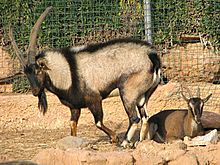Kri kri
| Kri-kri | |
|---|---|
 |
|
| Male and female in captivity | |
| Scientific classification | |
| Kingdom: | Animalia |
| Phylum: | Chordata |
| Class: | Mammalia |
| Order: | Artiodactyla |
| Family: | Bovidae |
| Subfamily: | Caprinae |
| Genus: | Capra |
| Species: | C. aegagrus |
| Subspecies: | C. a. cretica |
| Trinomial name | |
|
Capra aegagrus cretica (Schinz, 1838) |
|
The kri-kri (Capra aegagrus cretica), sometimes called the Cretan goat, Agrimi, or Cretan Ibex, is a feral goat inhabiting the Eastern Mediterranean, previously considered a subspecies of wild goat. The kri-kri is now found only on the island of Crete, Greece and three small islands just offshore (Dia, Thodorou and Agii Pantes).
The kri-kri has a light brownish coat with a darker band around its neck. It has two horns that sweep back from the head. In the wild they are shy and avoid humans, resting during the day. The animal can leap some distance or climb seemingly sheer cliffs.
The kri-kri is not thought to be indigenous to Crete, most likely having been imported to the island during the time of the Minoan civilization. Nevertheless, it is found nowhere else and is therefore endemic to Crete. It was once common throughout the Aegean but the peaks of the 2,400 m (8,000 ft) White Mountains of Western Crete are their last strongholds--particularly a series of almost vertical 900 m (3,000 ft) cliffs called 'the Untrodden'—at the head of the Samaria Gorge. This mountain range, which hosts another 14 endemic animal species, is protected as a UNESCO Biosphere Reserve. In total, their range extends to the White Mountains, the Samaria National Forest and the islets of Dia, Thodorou, and Agii Pandes. Recently some were introduced onto two more islands.
By 1960, the kri-kri was under threat, with a population below 200. It had been the only meat available to mountain guerillas during the German occupation in World War II. Its status was one reasons why the Samaria Gorge became a national park in 1962. There are still only about 2,000 animals on the island and they are considered vulnerable: hunters still seek them for their tender meat, grazing grounds have become scarcer and disease has affected them. Hybridization is also a threat, as the population has interbred with ordinary goats. Hunting them is strictly prohibited.
...
Wikipedia

